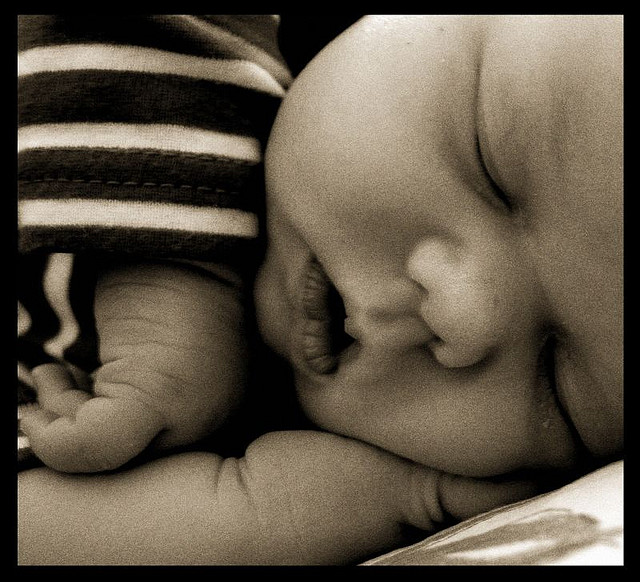8 Simple Rules for Baby Sleep

Perhaps the single most important element of establishing healthy baby sleep habits is a bedtime routine — a series of steps you follow every night, in the same order, to get your baby ready for bed. The bath-diaper-bottle-bed routine is a classic, and it works. The repetition begins to prepare your baby mentally for what’s coming, so that he or she is ready to fall asleep when placed in the crib. A consistent routine also helps you remember to do everything important (like change the diaper) before your baby goes down.
2. Fill that belly.
Newborns typically only sleep in 3-4 hour stretches, day and night, and that pattern is driven by their need to feed. Babies obviously eat more and more at a time as they grow, because they have bigger bellies and higher energy requirements. Keeping that belly full is critical to helping your baby sleep longer. The introduction of cereal and solid food — on your pediatrician’s advice, of course — will probably mark an important turning point in your baby’s ability to sleep all night.
3. Set an early bedtime.
In this modern world of work and day care and dining out, it’s easy for parents to keep their babies up well after the natural bedtime. You spend all day apart from your little one, and you want to get some quality time in! Even so, setting an early bedtime and sticking to it does wonders for your baby’s sleep habits. For most children under 2, the right bedtime is probably an hour or so after dinner. Certainly not 8 or 9 at night, when older children might go to bed. Babies need more sleep and they’re ready for bedtime earlier than you’d expect. It’s counter-intuitive, but an earlier bedtime often helps babies sleep longer.
4. Block out the light.
Last fall, one of my boys started waking up an hour earlier than usual, and we couldn’t figure out the cause. It was just after the daylight savings time change. Three or four mornings in a row, he was up super-early. Finally we realized that there was a crack between the window shade and the wall, and with sunrise coming an hour earlier, it allowed a sliver of sunlight through right onto our boy’s face, waking him up. Sunlight will get you every time, so we block it out systematically with room-darkening shades, heavy curtains, and in a pinch, a large baby book or two.
5. Use a pacifier.
The pacifier may be the most important baby invention ever. Few things are more soothing at bedtime, and we always make this the last part of the nightly routine. A pacifier can also come to the rescue if your baby wakes up unexpectedly at night or in the morning. For that reason we always keep a spare on our dresser.
6. Put the baby in the crib.
Teaching your little one to sleep in the crib is a cornerstone of sleep training. It’s the safest place for a baby to sleep, and it becomes part of the bedtime routine. Avoid the drop-side model cribs that have been discontinued due to safety concerns. Use a firm, fitted mattress and keep loose items out of the crib. Your little one doesn’t need pillows or teddy bears or crib bumpers
7. White noise.
Newborns seem to be fairly insensitive to noise, probably because the urge to sleep is so strong. Our daughter’s first outing as a newborn was to a parade, and she slept right through it. As they grow, however, babies engage more and more with the world around them. Sounds are no longer ignored; noises that you can’t control — the trash truck, the neighbor mowing his lawn, or a barking dog — can wake your baby up unexpectedly. To counter this, provide steady white noise with a fan or sound machine. This provides a steady hum to drown out errant noises. Ultimately, the sound becomes an auditory cue that it’s time for bed.
8. Dress for sleep.
At bedtime, put your baby in a clean diaper — preferably in a heavy duty overnight diaper — and soft, clean pajamas. These serve two purposes: a tactile cue that it’s time for bed, and extra comfort to help your baby sleep longer. Top it off with a swaddler or sleep sack, and he or she can sleep all night in snug comfort.
Dan Koboldt is the author of Get Your Baby to Sleep, a central resource to help parents establish healthy sleep habits and teach their babies to sleep through the night.
Tags: baby sleep, guest



2 thoughts on “8 Simple Rules for Baby Sleep”